Drawing and Painting Botanicals for Artists: How to Create Beautifully Detailed Plant and Flower Illustrations (Volume 4) (For Artists, 4)
$12.99

Price: $12.99
(as of Nov 03,2023 23:42:18 UTC – Details)
Originally developed in the 18th century as a visual supplement to botanical nomenclature, botanical illustration and art uniquely fuse art and science by documenting the parts, details, and life cycles of plant species. In Drawing and Painting Botanicals for Artists, eminent botanical artist and veteran workshop instructor Karen Kluglein reveals her secrets for rendering leaves, flowers, berries, and branches both accurately and beautifully.
The book begins with a brief history of the art form, followed by guidance on developing observational skills for this genre, key botanical terms and concepts, and the differences among botanical illustration, botanical art, and flower painting. The chapters that follow offer detailed guidance and demonstrations for drawing and painting botanicals in a variety of mediums: Drawing. Explore loose gestural drawing, precise measuring and rendering, and working from photographs with graphite, colored pencil, finepoint markers, pen and ink, and silverpoint.Painting. Master color mixing, washes, layering, gradations, values, and adding details in watercolor, gouache, and acrylic, plus guidance on adding “personality” to your work and knowing when a painting is done.Drawing and Painting Botanicals for Artists shows artists at all skill levels how to translate careful observations into stunning works of art.
The For Artists series expertly guides and instructs artists at all skill levels who want to develop their classical drawing and painting skills and create realistic and representational art.
From the Publisher
Drawing and Painting Botanicals for Artists: How to Create Beautifully Detailed Plant and Flower Illustrations


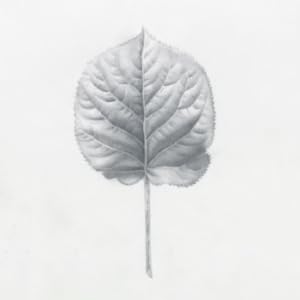



INTRODUCTION
In botanical art, we’re enhancing what we see in the specimen before us. The bend of a stem or curve of a leaf can be changed to artfully portray our subject. We begin with scientific accuracy, being mindful of extracting details in every possible way. But then the artistic part comes in and we can take some liberties to make the image our own.
There are no shortcuts with this style of botanical art. Botanical drawings show minute detail and bring out form and textures in much the same way as painting; the only difference is the medium used. It can be labor-intensive, especially with the watercolor finishing work of details and drybrush.
DRAWING BOTANICALS
Proficiency in drawing is by far the most important quality needed in creating traditional botanicals. Hours spent observing and drawing what you see will be of enormous benefit later when you work with the added complexities of applying paint.
With drawing, we can eliminate those questions and concerns and focus on what we see in the specimen before us. Choose a simply shaped flower or leaf that appeals to you. You’re going to be looking at it for a long time. Look through your garden; have your eyes open during a walk in the woods or even in the produce aisle at the grocery store. You never know when you’ll find that perfect peach to draw!
PAINTING BOTANICALS
In botanical painting, we use knowledge gained from drawing and add in the complexities of working with fluid color. Prior to photography, botanical painting was the only way to document the world’s varied plant life. Specimens were depicted accurately for identification purposes, and the colors used were an important part of that identification.
Most botanical paintings are created in watercolor—the medium that was used most often long ago and is still most popular today. Delicate washes accurately mimic the transparency of petals, tiny brushes can create the minute detail in a flower, and colors are matched to the specimen for accuracy.
Beach Rose in Fine Point Marker
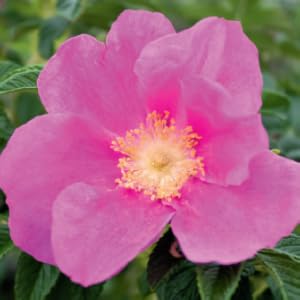

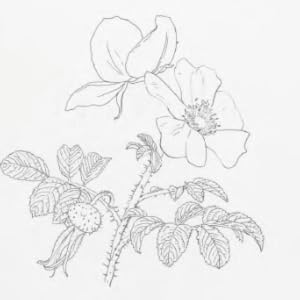



I created this beach rose (Rosa rugosa) sketch using both a photo and small cutting from the plant for reference. I chose this subject because the amount of detail involved made it an excellent choice for an ink drawing. For paper, I used a clay coated, sealed, pen and ink paper. I did not use a graphite sketch first, but instead drew directly on the paper. If you prefer, you can always make a light sketch on your paper and then erase the pencil lines after your ink drawing is complete.
Supplies
Clay coated pen and ink paperMicron fine point markers, Nos. 08, 05, and 005
1. Draw the leaves and petals one at a time, comparing the proportions as the drawing progresses. To make the thicker lines, hold the marker at an angle or apply more pressure. To make the thinner lines, hold the marker at a perpendicular angle to the paper and apply light pressure.
2. Once the main outlines are drawn, add the finer details, showing veining and contours. Indicate shadows using fine lines and dots. Make the darker shadows with dots (stippling) applied close together. These shadows bring out the rounded shape and volume of the beach plums and contours of the leaves. Because the petals have less detail, apply the ink with a lighter touch so that they don’t appear too heavy.
How to Change a Petal’s Shape
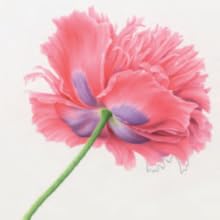



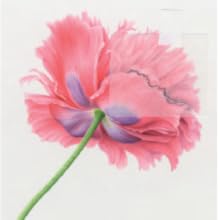

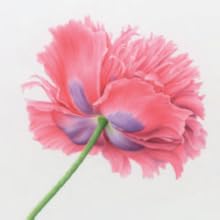

A petal’s shape can be changed and expanded into a white background.
A blotted damp brush with a sharp point is applied over the line and a paper towel is pushed into it. Make sure when doing this that your clean paper towel is dry. I keep one folded paper towel next to my water cup to blot excess in the brush and a clean paper towel in my left hand to blot paint from the paper. After these small lines are picked up, the area can be smoothed with drybrush and new veins added.
Edges of petals can be moved and changed as well. It’s easy to make the petal’s edge larger when you’re expanding it into a white background. With graphite, lightly draw the new petal’s shape. Wet and blot the edge that’s going to be expanded to soften if needed. Then, add washes and complete the petal in the new area. The contours of the expanded petal should flow seamlessly from old to new.
If the petal you wish to enlarge encroaches into a dark area, the paint in the dark area needs to be picked up. If you want to paint a pink petal where there had been a green leaf, you’ll need to remove as much green as possible. The success of this depends on the paper and paints used, but it’s possible to do. A color change from dark to light will be more successful in a small area than a large one. Wet the area you wish to pick up and blot with your paper towel. A dark color may need gentle scrubbing, blotting, and perhaps erasing when the surface is completely dry. Carefully paint in the new petal. Drybrush will be needed to make smooth gradations.
A petal’s straight edge can be made more undulating by lifting and adding paint as needed.
Publisher : Rockport Publishers (June 16, 2020)
Language : English
Paperback : 144 pages
ISBN-10 : 1631598570
ISBN-13 : 978-1631598579
Item Weight : 1.3 pounds
Dimensions : 8.6 x 0.5 x 11 inches
User Reviews
Be the first to review “Drawing and Painting Botanicals for Artists: How to Create Beautifully Detailed Plant and Flower Illustrations (Volume 4) (For Artists, 4)”

$12.99







There are no reviews yet.